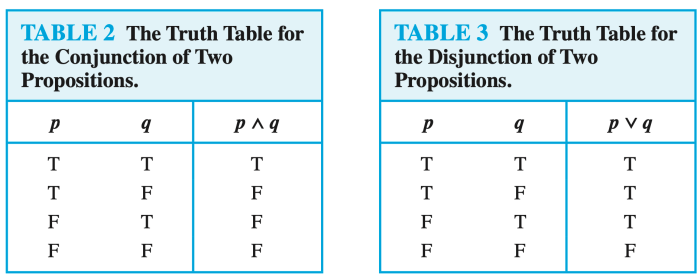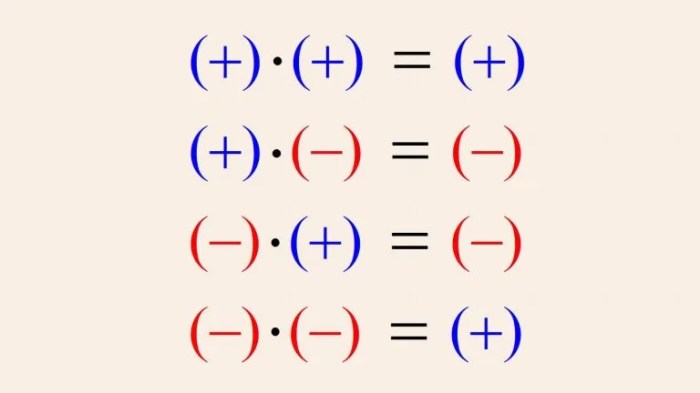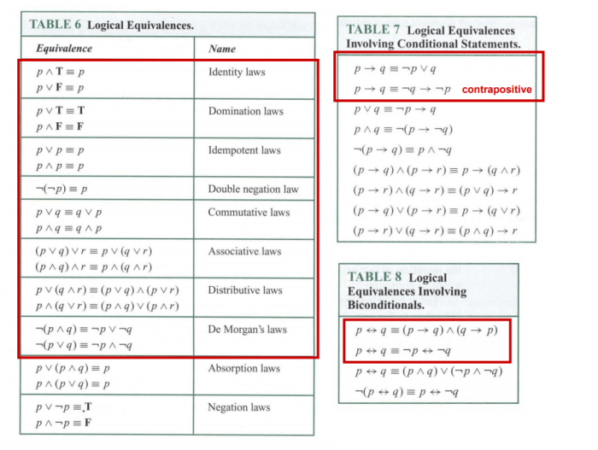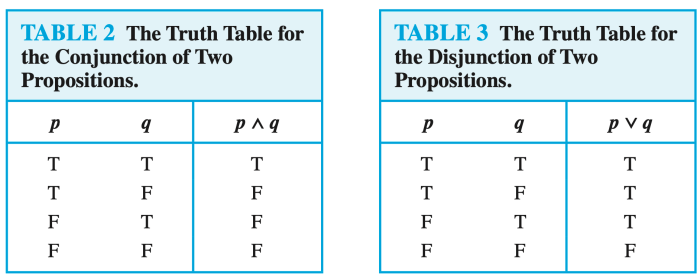
What is the law of sings – What is the law of signs takes center stage, inviting you to explore the fascinating world of mathematics where numbers dance with both positive and negative values. This fundamental concept, governing the arithmetic of signed numbers, is a cornerstone of algebra and beyond. It guides us through the intricacies of multiplication, division, addition, and subtraction, ensuring that we navigate the realm of positive and negative numbers with confidence.
The law of signs, like a compass, helps us understand the direction of our calculations, ensuring that we arrive at the correct results. From basic arithmetic to complex equations, its application is widespread, making it a crucial tool for anyone seeking to master the art of mathematics.
Introduction to the Law of Signs

The Law of Signs is a fundamental principle in mathematics that governs the operations of addition, subtraction, multiplication, and division with positive and negative numbers. It simplifies calculations and provides a consistent framework for understanding the interactions between numbers with different signs.
The Law of Signs states that:
* The product or quotient of two numbers with the same sign is positive.
* The product or quotient of two numbers with different signs is negative.
Historical Development and Significance
The Law of Signs has been recognized and utilized for centuries, with its roots tracing back to ancient civilizations. The concept of negative numbers, however, was initially met with resistance and skepticism. The ancient Greeks, for instance, struggled to grasp the idea of numbers less than zero.
During the Renaissance, mathematicians like Leonardo Fibonacci and Michael Stifel made significant contributions to understanding negative numbers and their properties. The development of algebra, particularly the use of symbols for unknown quantities, further propelled the acceptance and application of the Law of Signs.
The Law of Signs is a cornerstone of modern algebra and is essential for understanding and solving various mathematical problems. Its applications extend beyond theoretical calculations and are employed in diverse fields, including physics, engineering, economics, and computer science.
Real-World Examples
The Law of Signs finds practical applications in various real-world scenarios:
* Finance: In financial transactions, the Law of Signs helps determine profit or loss. A positive value represents profit, while a negative value indicates a loss.
* Temperature: The Law of Signs is crucial in understanding temperature scales. For example, a temperature of -10 degrees Celsius represents a colder temperature than 0 degrees Celsius.
* Velocity: In physics, velocity is a vector quantity that has both magnitude and direction. Positive velocity indicates movement in one direction, while negative velocity indicates movement in the opposite direction.
* Computer Programming: The Law of Signs is fundamental in computer programming, where it governs the behavior of arithmetic operations, particularly in conditional statements and loops.
Multiplication of Signed Numbers
The multiplication of signed numbers involves understanding how the signs of the numbers being multiplied affect the sign of the product. The Law of Signs provides a simple and consistent rule for determining the sign of the product.
Multiplication of Signs
The multiplication of signs follows a simple pattern that can be summarized in a table:
| Sign of First Number | Sign of Second Number | Sign of Product |
|---|---|---|
| Positive (+) | Positive (+) | Positive (+) |
| Positive (+) | Negative (-) | Negative (-) |
| Negative (-) | Positive (+) | Negative (-) |
| Negative (-) | Negative (-) | Positive (+) |
Examples of Multiplication of Signed Numbers
The Law of Signs is applied in numerous practical scenarios, such as calculating financial transactions, measuring temperature changes, and analyzing data in scientific fields.
-
Example 1: Multiplying a positive number by a negative number.
5 x (-3) = -15
In this example, a positive number (5) is multiplied by a negative number (-3), resulting in a negative product (-15).
-
Example 2: Multiplying two negative numbers.
(-2) x (-4) = 8
In this example, two negative numbers (-2 and -4) are multiplied, resulting in a positive product (8).
-
Example 3: Multiplying multiple signed numbers.
(-3) x 2 x (-1) = 6
In this example, we multiply three signed numbers. The product of the first two numbers (-3 x 2) is -6. Then, multiplying -6 by -1 gives a positive product of 6.
Division of Signed Numbers
Division of signed numbers follows similar rules to multiplication, with the outcome depending on the signs of the dividend (the number being divided) and the divisor (the number dividing).
Rules for Dividing Signed Numbers
The rules for dividing signed numbers are:
- Dividing two numbers with the same sign (both positive or both negative) results in a positive quotient.
- Dividing two numbers with different signs (one positive and one negative) results in a negative quotient.
Comparison with Multiplication of Signed Numbers
The rules for dividing signed numbers are identical to the rules for multiplying signed numbers:
- Same signs: Both multiplication and division result in a positive outcome.
- Different signs: Both multiplication and division result in a negative outcome.
Examples of Division Problems Involving Signed Numbers
Here are some examples of division problems involving signed numbers:
- 12 ÷ 4 = 3 (Both positive, resulting in a positive quotient)
- -12 ÷ 4 = -3 (Different signs, resulting in a negative quotient)
- -12 ÷ -4 = 3 (Both negative, resulting in a positive quotient)
- 12 ÷ -4 = -3 (Different signs, resulting in a negative quotient)
Addition and Subtraction of Signed Numbers

Adding and subtracting signed numbers might seem tricky at first, but it becomes clear when you understand the concept of number lines and follow the rules. This section will guide you through these operations, making them easy to grasp.
Number Lines and Signed Numbers
Number lines are visual representations of numbers, extending infinitely in both positive and negative directions. They are particularly useful for visualizing addition and subtraction of signed numbers.
The number line is divided into equal intervals, with zero as the center. Positive numbers are located to the right of zero, while negative numbers are to the left.
To understand how number lines help in adding and subtracting signed numbers, consider these examples:
1. Adding Positive Numbers: Start at zero and move to the right (positive direction) the number of units indicated by the positive number. For instance, adding 3 to 5 would mean moving 3 units to the right from 5 on the number line, resulting in 8.
2. Adding Negative Numbers: Start at zero and move to the left (negative direction) the number of units indicated by the negative number. For example, adding -3 to 5 would mean moving 3 units to the left from 5 on the number line, resulting in 2.
3. Subtracting Positive Numbers: Start at the first number and move to the left (negative direction) the number of units indicated by the positive number. For instance, subtracting 3 from 5 would mean moving 3 units to the left from 5 on the number line, resulting in 2.
4. Subtracting Negative Numbers: Start at the first number and move to the right (positive direction) the number of units indicated by the negative number. For example, subtracting -3 from 5 would mean moving 3 units to the right from 5 on the number line, resulting in 8.
Rules for Adding and Subtracting Signed Numbers
Here are the rules for adding and subtracting signed numbers:
- Adding Numbers with the Same Sign: Add the absolute values of the numbers and keep the common sign. For example, 3 + 5 = 8 and -3 + (-5) = -8.
- Adding Numbers with Different Signs: Subtract the smaller absolute value from the larger absolute value and keep the sign of the number with the larger absolute value. For example, 3 + (-5) = -2 and -3 + 5 = 2.
- Subtracting Numbers: Change the sign of the number being subtracted and then follow the rules for addition. For example, 3 – 5 = 3 + (-5) = -2 and -3 – 5 = -3 + (-5) = -8.
Step-by-Step Guide for Solving Problems
To solve addition and subtraction problems with signed numbers, follow these steps:
1. Identify the signs of the numbers involved.
2. Apply the appropriate rule based on the signs.
3. Perform the calculation, keeping track of the sign.
4. Write the final answer with the correct sign.
Example:
-5 + 3 – (-2)
Step 1: Identify the signs. -5 is negative, 3 is positive, and -2 is negative.
Step 2: Apply the rules. For -5 + 3, subtract the smaller absolute value from the larger absolute value (5 – 3 = 2) and keep the sign of the number with the larger absolute value (negative). So, -5 + 3 = -2.
Step 3: Change the sign of the number being subtracted. – (-2) becomes +2.
Step 4: Perform the calculation. -2 + 2 = 0.
Therefore, -5 + 3 – (-2) = 0.
Applications of the Law of Signs: What Is The Law Of Sings

The Law of Signs, a fundamental concept in mathematics, plays a crucial role in solving equations, inequalities, and various real-world problems. This section explores how the Law of Signs is applied in diverse scenarios, demonstrating its importance in various fields.
Solving Equations and Inequalities
The Law of Signs is instrumental in solving equations and inequalities involving signed numbers. It helps determine the sign of the solution, leading to a more accurate and efficient approach to problem-solving.
Equations
Consider the equation:
x + 5 = -3
To solve for x, we need to isolate it. Subtracting 5 from both sides, we get:
x = -3 – 5
Applying the Law of Signs for subtraction, we know that subtracting a positive number is equivalent to adding its negative counterpart. Therefore:
x = -3 + (-5)
Adding two negative numbers results in a negative sum:
x = -8
Thus, the solution to the equation x + 5 = -3 is x = -8.
Inequalities
The Law of Signs is equally important in solving inequalities. For instance, consider the inequality:
2x – 4 > 6
To solve for x, we need to isolate it. Adding 4 to both sides, we get:
2x > 6 + 4
Simplifying the right side:
2x > 10
Dividing both sides by 2, we get:
x > 5
This inequality indicates that any value of x greater than 5 will satisfy the original inequality. The Law of Signs was crucial in determining the direction of the inequality sign, ensuring that the solution accurately reflects the original inequality.
Real-World Scenarios
The Law of Signs is essential for problem-solving in various real-world scenarios, including:
Finance
In finance, the Law of Signs is used to calculate profits and losses. For example, a positive profit indicates a gain, while a negative profit represents a loss. Similarly, a positive investment return signifies growth, while a negative return indicates a decline.
Physics
In physics, the Law of Signs is used to represent directions and magnitudes. For instance, a positive velocity indicates movement in one direction, while a negative velocity signifies movement in the opposite direction. The Law of Signs is also used in calculating forces, where a positive force indicates a push, and a negative force represents a pull.
Temperature
The Law of Signs is used to represent temperature. A positive temperature indicates a temperature above freezing, while a negative temperature represents a temperature below freezing.
Examples, What is the law of sings
Here are some examples of how the Law of Signs is applied in different fields:
Finance
A company has a profit of $50,000 in one quarter and a loss of $20,000 in the next quarter. To calculate the overall profit or loss for the two quarters, we can use the Law of Signs:
Overall profit = $50,000 + (-$20,000) = $30,000
The positive sign indicates that the company had an overall profit of $30,000 for the two quarters.
Physics
A car travels 50 meters east and then 20 meters west. To calculate the car’s net displacement, we can use the Law of Signs. Assuming east is positive and west is negative:
Net displacement = 50 meters + (-20 meters) = 30 meters
The positive sign indicates that the car’s net displacement is 30 meters east.
Temperature
The temperature in a city is 10 degrees Celsius above freezing. The temperature drops by 5 degrees Celsius. To calculate the new temperature, we can use the Law of Signs:
New temperature = 10 degrees Celsius + (-5 degrees Celsius) = 5 degrees Celsius
The positive sign indicates that the new temperature is still above freezing.
Concluding Remarks
The law of signs, in its simplicity, unlocks a universe of possibilities in mathematics. It empowers us to solve equations, unravel inequalities, and tackle real-world problems with a clear understanding of the interplay between positive and negative values. Whether you are a student embarking on your mathematical journey or a seasoned professional, mastering the law of signs is a key to unlocking the full potential of this captivating field.
FAQ Insights
Why is the law of signs important in mathematics?
The law of signs is essential because it provides a consistent framework for performing arithmetic operations with both positive and negative numbers. It ensures that we obtain accurate results, regardless of the signs involved.
What are some real-world applications of the law of signs?
The law of signs finds applications in various fields, including finance (calculating profits and losses), physics (representing forces and motion), and engineering (analyzing stress and strain).
Can you explain the difference between the law of signs for multiplication and division?
The law of signs is consistent for both multiplication and division. When multiplying or dividing numbers with the same sign (both positive or both negative), the result is positive. When multiplying or dividing numbers with opposite signs (one positive and one negative), the result is negative.


